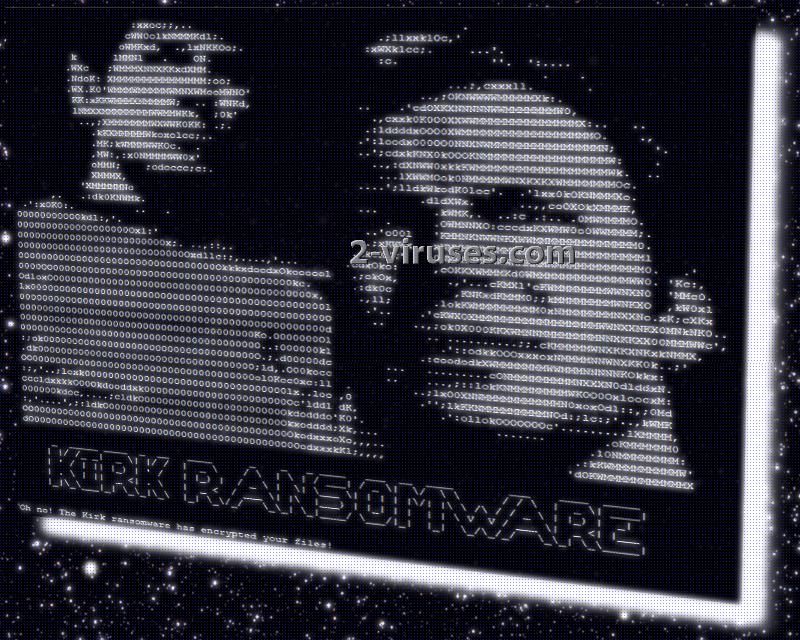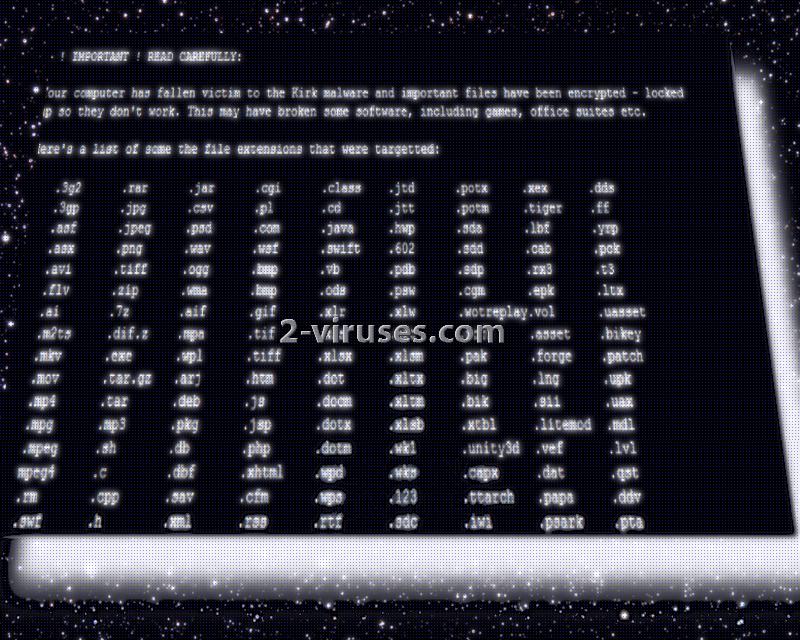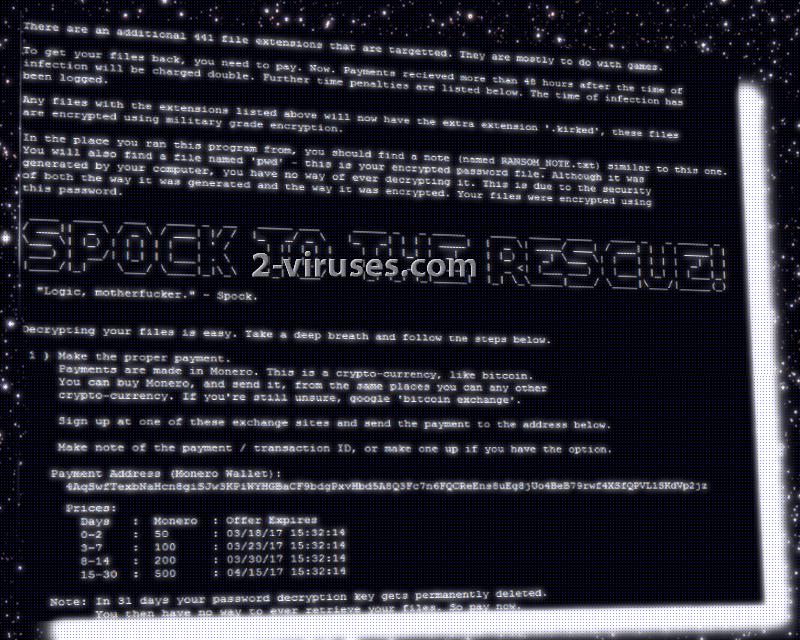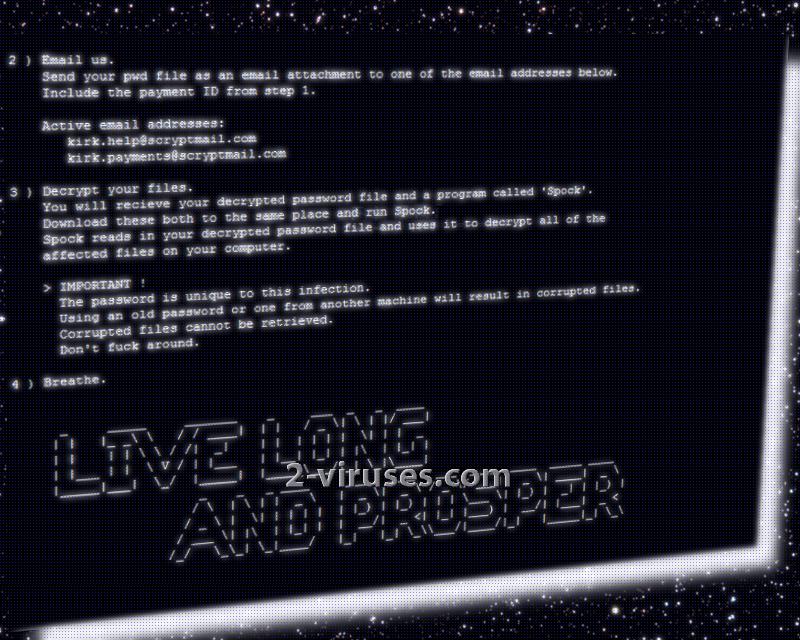Star Trek fans should immediately recognize the name Kirk, and after looking at the representative picture of this infection, there should be no doubt that this crypto-virus is based on this science fiction media franchise. Hackers that developed Kirk virus decided not to limit their Star Trek references and attempted to exploit every opportunity possible to include something from the popular series. However, references to Star Trek is not the only element, making Kirk ransomware unique. To learn more about this variant, continue on reading this article. Currently, despite being created, Kirk virus does not appear to be actively distributed.
Analysis of Kirk virus: its activity and demands
To create Kirk virus, crooks used the Python programming language. One of the most unusual aspects about this infection is that instead of demanding victims to make transactions via the Bitcoin payment system, they exploit a novel cryptocurrency. Fees for file decryption are supposed to be sent via Monero system and this is a noteworthy detail to mention. Crooks might have decided to go with Monero because this system is explained to be even more secure and private than bitcoin. While buying bitcoins is relatively easy and many people have already been involved with them in one way or another, Monero is something that users are yet to learn.
The picture above shows the first thing people see after their devices are invaded: two faces that are made from random letters and numbers. Then, victims will be informed about the situation: their devices have been conquered by Kirk malware. It appears to be that this ransomware might not be opting to leave crucial files as they were: it can encrypt data which is responsible for the proper functioning of a device. Kirk virus can severely damage all sorts of files. Here is a few of them:
.doc, .docx, .pdf, .rar, .jpg, jpeg, .zip, .7z, .mp3, .mov, .txt, .gif, .csv, .bmp, .htm, .ppt, .key, .ods, and hundreds of others. All of the selected files will be ruined with AES algorithm and will be forced to welcome an addition extension: .kirked.
As soon as the Kirk virus launches its informative window of demands, it will start counting the time and waiting for a payment to end up in their Monero wallet. After 2 days, the demanded sum (initial price is 50 Monero) will be doubled as these hackers appear to be very inpatient, but willing to wait for victims’ to come to their senses and pay. Since currently there is no way of defeating Kirk virus, its victims could consider making a transaction to hackers for the sake of recovering their files. However, we do not think this idea to be good. After the 7th day of not paying the ransom, the ransom will grow into 200 Monero. After two weeks, the price reaches 500 Monero. After a month of not paying, the private key will be deleted without a trace.
How does Kirk virus complement encryption of files? In this case, tactics are pretty common. Af first, files are encrypted with AES public key. Then, once the private key is the only way of restoring files, this secret code will be encrypted with RSA. Actually, the AES public key remains in an infected device, more specifically, in a pwd file which should be in the same location as the ransom note RANSOM_NOTE.txt.
If people are considering paying the ransom, they should not delete the pwd file: it has to be send to the provided emails. Of course, before victims’ contact hackers, shady programmers have to receive the required amount of Monero to their indicated wallet. The email addresses to write to are the following: kirk.help@scryptmail.com and kirk.payments@scryptsmail.com. After hackers are pleased with the money they receive, they will allegedly share “Spock” (a tool for decryption) with the victims.
Our suggestions, concerning file-decryption
Kirk ransomware is a new variant and it has not infected many people. In fact, it has not infected anybody. However, this might be just a matter of time until necessary measures will be used to distribute this interesting but fearsome virus. As for the methods that could be used in order to retrieve files, you should consider storing your files in backup storages. If a ransomware infection strikes, you will have no need to worry as your files will be retrievable from another location. A ransomware has already invaded your privacy? Try to restore files using Shadow Volume Copies or apply universal file-recovery tools.
Kirk virus: how is it spread?
It is yet unknown how Kirk ransomware could infect devices. It might be that its payload, named loic_win32.exe, will be hidden in malicious spam letters. It could be that exploit kits will be responsible for its successful arrival in devices. Whichever the case, we advise you to be cautious. Once infected with ransomware, it will be very difficult to step out of this issue dry. You might lose your files permanently or pointlessly send bitcoins/monero. Before trying to restore files with alternative techniques, always remove the ransomware first. Spyhunter or Hitman will help you get rid of Kirk ransomware.
Kirk Virus quicklinks
- Analysis of Kirk virus: its activity and demands
- Our suggestions, concerning file-decryption
- Kirk virus: how is it spread?
- Automatic Malware removal tools
- How to recover Kirk virus encrypted files and remove the virus
- Step 1. Restore system into last known good state using system restore
- 1. Reboot your computer to Safe Mode with Command Prompt:
- 2.Restore System files and settings.
- Step 4. Use Data Recovery programs to recover Kirk virus encrypted files
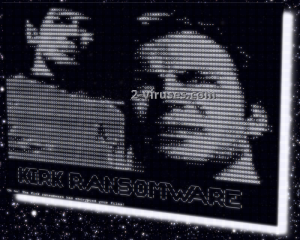
Automatic Malware removal tools
(Win)
Note: Spyhunter trial provides detection of parasites and assists in their removal for free. limited trial available, Terms of use, Privacy Policy, Uninstall Instructions,
(Mac)
Note: Combo Cleaner trial provides detection of parasites and assists in their removal for free. limited trial available, Terms of use, Privacy Policy, Uninstall Instructions, Refund Policy ,
How to recover Kirk virus encrypted files and remove the virus
Step 1. Restore system into last known good state using system restore
1. Reboot your computer to Safe Mode with Command Prompt:
for Windows 7 / Vista/ XP
- Start → Shutdown → Restart → OK.
- Press F8 key repeatedly until Advanced Boot Options window appears.
- Choose Safe Mode with Command Prompt.

for Windows 8 / 10
- Press Power at Windows login screen. Then press and hold Shift key and click Restart.

- Choose Troubleshoot → Advanced Options → Startup Settings and click Restart.
- When it loads, select Enable Safe Mode with Command Prompt from the list of Startup Settings.

2.Restore System files and settings.
- When Command Prompt mode loads, enter cd restore and press Enter.
- Then enter rstrui.exe and press Enter again.

- Click “Next” in the windows that appeared.

- Select one of the Restore Points that are available before Kirk ransomware has infiltrated to your system and then click “Next”.

- To start System restore click “Yes”.

Step 2. Complete removal of Kirk virus
After restoring your system, it is recommended to scan your computer with an anti-malware program, like Spyhunter and remove all malicious files related to Kirk ransomware. You can check other tools here.Step 3. Restore Kirk virus affected files using Shadow Volume Copies
If you do not use System Restore option on your operating system, there is a chance to use shadow copy snapshots. They store copies of your files that point of time when the system restore snapshot was created. Usually Kirk ransomware tries to delete all possible Shadow Volume Copies, so this methods may not work on all computers. However, it may fail to do so. Shadow Volume Copies are only available with Windows XP Service Pack 2, Windows Vista, Windows 7, and Windows 8. There are two ways to retrieve your files via Shadow Volume Copy. You can do it using native Windows Previous Versions or via Shadow Explorer. a) Native Windows Previous Versions Right-click on an encrypted file and select Properties → Previous versions tab. Now you will see all available copies of that particular file and the time when it was stored in a Shadow Volume Copy. Choose the version of the file you want to retrieve and click Copy if you want to save it to some directory of your own, or Restore if you want to replace existing, encrypted file. If you want to see the content of file first, just click Open.
b) Shadow Explorer It is a program that can be found online for free. You can download either a full or a portable version of Shadow Explorer. Open the program. On the left top corner select the drive where the file you are looking for is a stored. You will see all folders on that drive. To retrieve a whole folder, right-click on it and select “Export”. Then choose where you want it to be stored.

Step 4. Use Data Recovery programs to recover Kirk virus encrypted files
There are several data recovery programs that might recover encrypted files as well. This does not work in all cases but you can try this:- We suggest using another PC and connect the infected hard drive as slave. It is still possible to do this on infected PC though.
- Download a data recovery program.
- Install and scan for recently deleted files.

